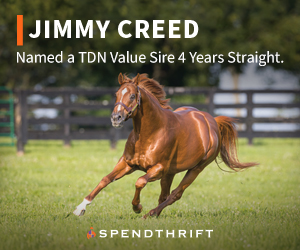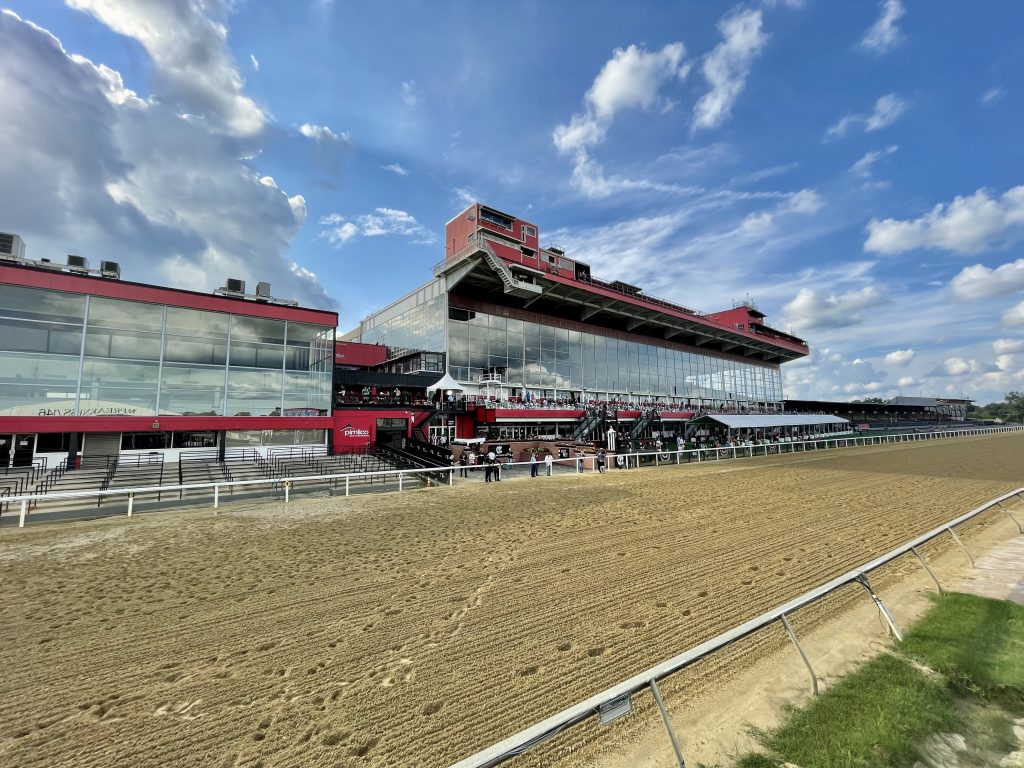
Maryland Jockey Club hosted Maryland Pride and Fan Appreciation
SIDE RAIL: The history of the infield cupola
What’s in Pimlico’s future? How did we get where we are?
It might have been cloudy over Baltimore Saturday, August 21, but the sky was blue over Pimlico Race Course. On last weekend of live racing, the Maryland Jockey Club (MJC) rolled out the green carpet and the stakes races for patrons for “Maryland Pride Day.” And they rolled out the perks for “Fan Appreciation Day” the minute you walked in the door with free programs and bags full of Preakness swag.
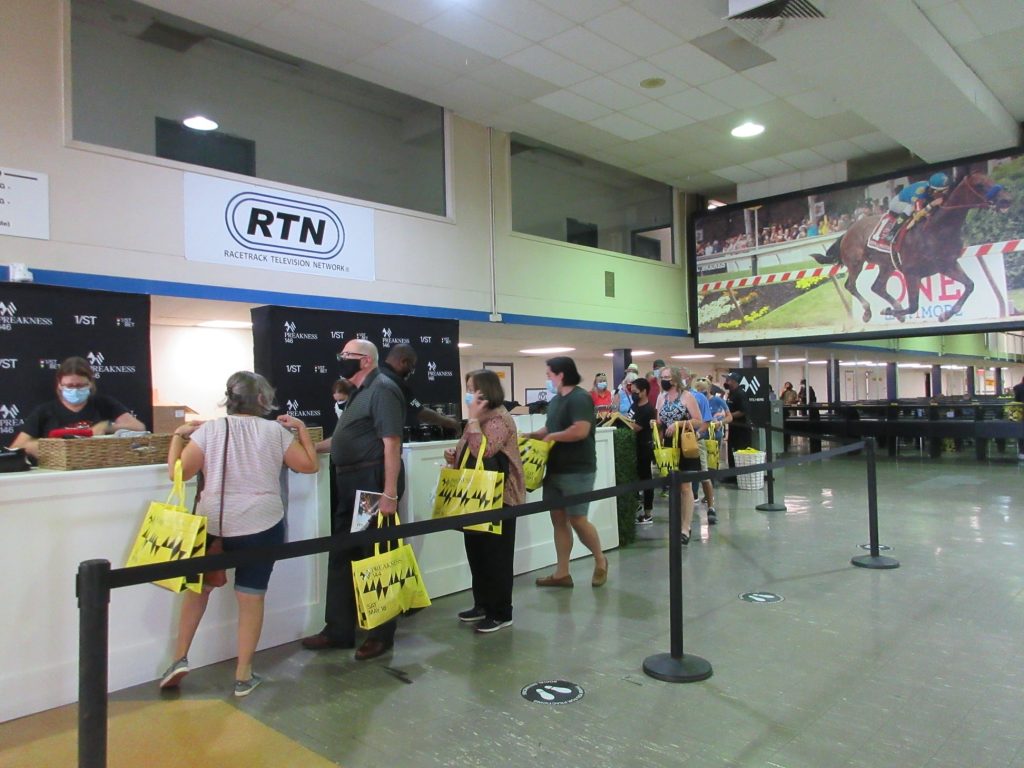
Fans stand in line to get free Preakness items. (April Inloes Smith)
Fans were treated to a Preakness 145 bright yellow carry bag to put anything they desired at the table for free which included a variety of Preakness t-shirt designs, hats, sought-after Preakness glasses, shot glasses, collectible pins and more. Patrons were lining up to get the goodies.
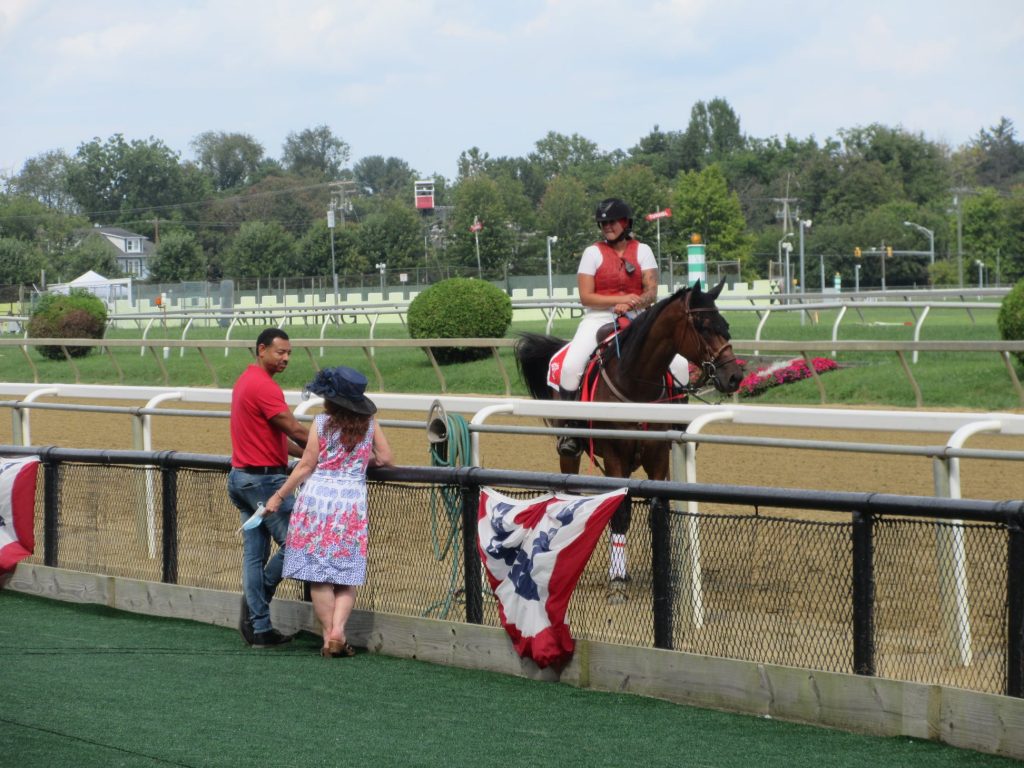
Trainer Troy Holland and horse owner Michele J. Parsells on the green carpet along the rail chatting with an outrider. (April Inloes Smith)
When you walked out onto the grandstand apron a refreshing faux green grass carpet greeted fans with a tent partially covering the area for shade over picnic tables.
For the convenience of those in attendance there were tellers with iPads walking through the crowd taking bets. And vendors with beer and Black-eyed Susans bringing refreshments right to your table—picnic table.
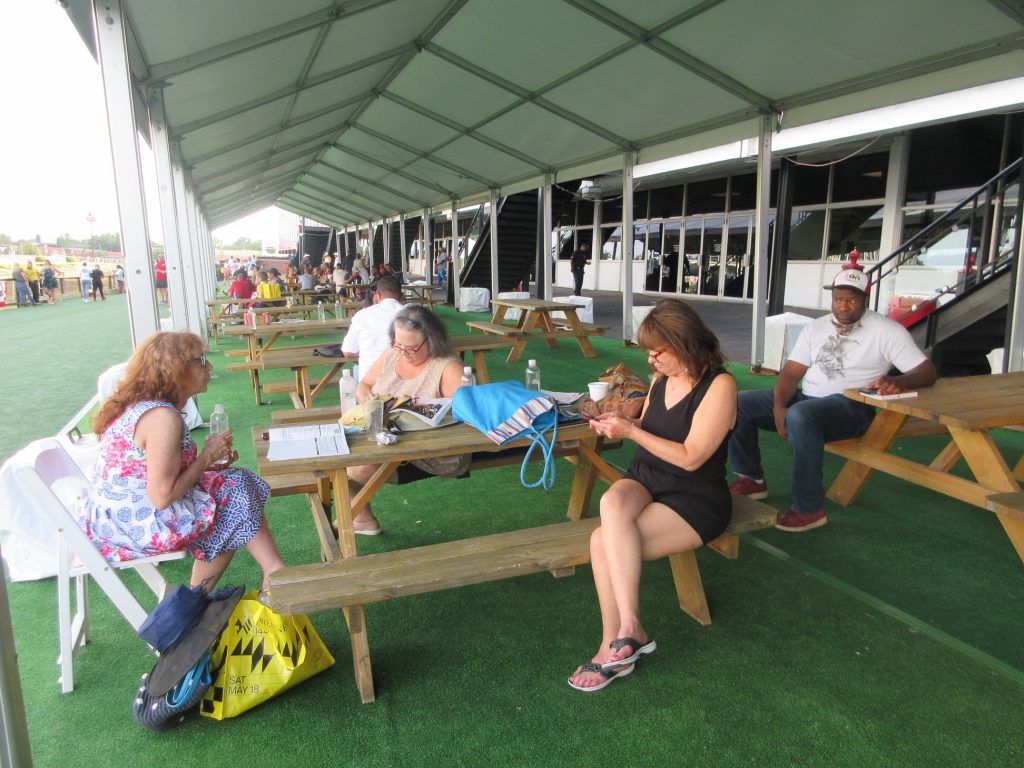
(Left to right) Michele J. Parsells, Maribeth Kalinich, Marilyn P. Bobby and Kevin Grace sit in the covered grandstand area. (April Inloes Smith)
For fans who prefer the sunny side, picnic tables were set up in front of the old grandstand (built in 1922).
A nice-size crowd of all ages attended with lots of kids, too. It was wonderful to see youngsters enjoying the horses and fresh air. You will never meet friendlier people than at a racetrack!
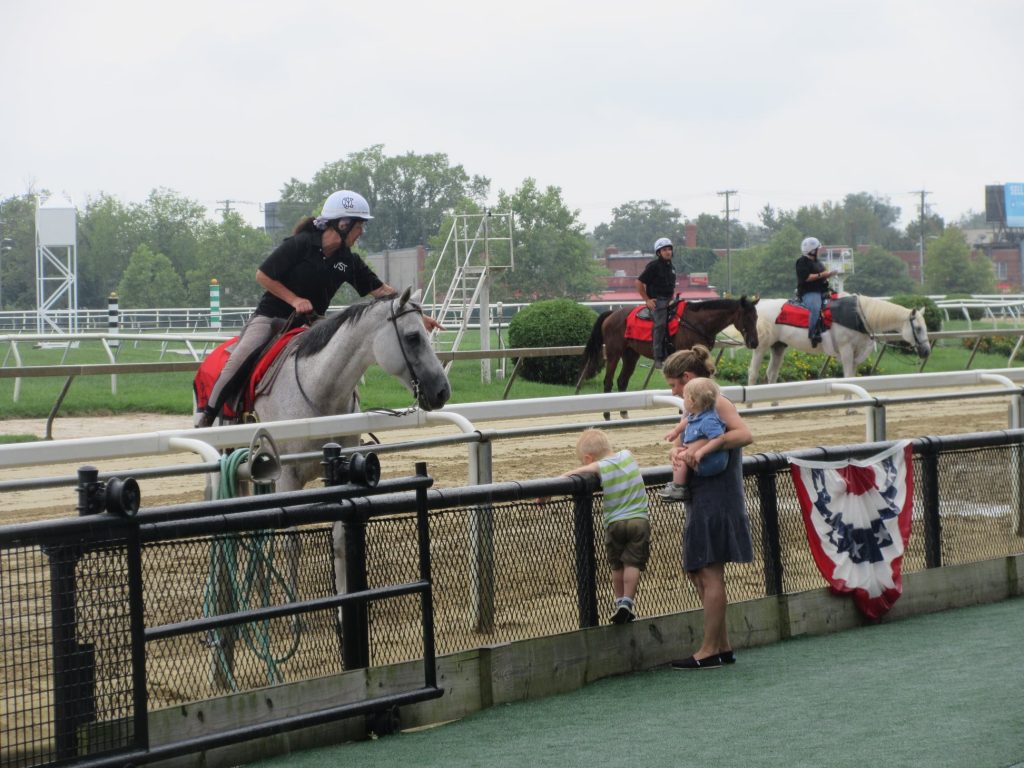
A young family chats with pony rider Christine M. Higgs. Higgs said: “[Pimlico is] My home track. First got my license at Pimlico I 14 years old work permit in hand. Worked for Richard Delp. (April Inloes Smith)
Also, in attendance was an army of photojournalists from Maryland to document the day. In addition to Maryland Jockey Club’s track photographers Jim McCue and Jerry Dzierwinski, Allison Janezic of TheRacingBiz, Scott Serio and his crew from EquiSport Photos and several freelancers including Barbara Magrogan and Lydia Williams were on the rail lens in hand. We are so lucky to have such talented people who capture racing history in real-time.
A Maryland Day At The Races
Pimlico’s apron and rail are level with the track, so you are right where the racing action happens. And there was plenty of racing action as it was also “Maryland Pride Day” with a 10-race Maryland Pride Day program including four $75,000 stakes restricted to Maryland-bred/sired horses.
$75,000 Miss Disco for 3-year-old fillies, the 28th running of the $75,000 Star de Naskra for 3-year-olds sprinting six furlongs was, and a pair of 1 1/16-mile turf stakes, the $75,000 Find for 3-year-olds and up and $75,000 All Brandy for fillies and mares 3 and older.
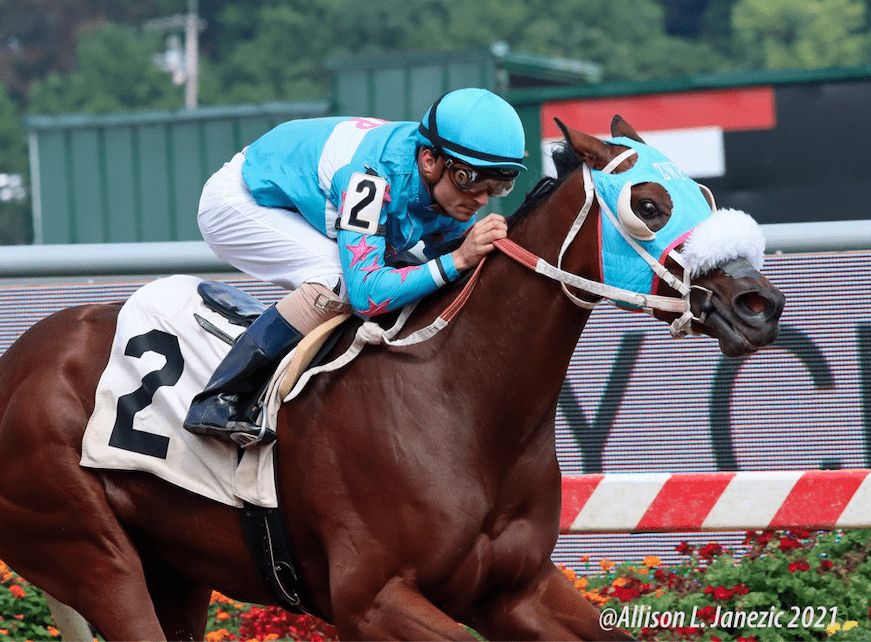
Malibu Beauty with Sheldon Russell up went gate-to-wire to win her first stakes in the Miss Disco. (Allison Janezic)
ZWP and Non-Stop Stable’s homebred Malibu Beauty registered her fourth win in the last six starts and first in a stakes, going gate to wire under Sheldon Russell to capture the $75,0000 Miss Disco by 4 ½ lengths.
Malibu Beauty ($2.80) and her Gary Capuano-trained stablemate Hitch a Ride are both front-running types, but it was the former that go to the lead first from Post 2 and held it through fractions of 23.26 and 46.56 seconds pressed by Response Time. The top two made the turn together while My My Girl swung outside to make a run and Hitch a Ride hugged the rail.
Malibu Beauty has been first or second in her last six starts, with each of her two losses coming by a half-length – one to Street Lute in the June 13 Stormy Blues at Pimlico, and the other against elders in an open allowance July 1 at Delaware Park.
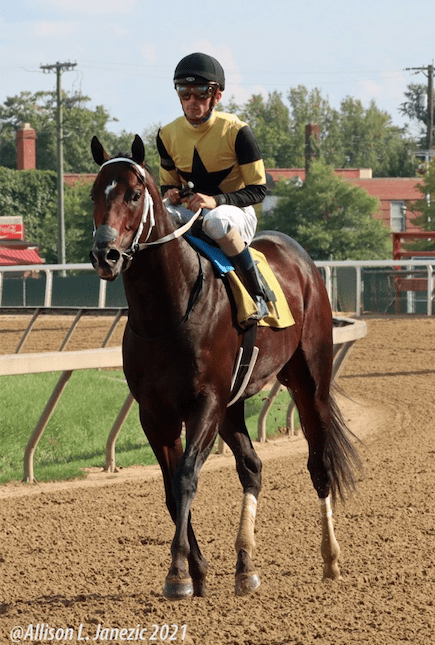
Sheldon Russell aboard Jaxon Traveler getting ready for the Star de Naskra. Russell scored his second stakes of the day as they sprinted to victory. (Allison Janezic)
West Point Thoroughbreds and Marvin Delfiner’s Jaxon Traveler added a third stakes win to his resume, the second in his home state of Maryland, with a professional three-length triumph in Saturday’s $75,000 Star de Naskra.
Ridden for the first time by Sheldon Russell for Hall of Fame trainer Steve Asmussen, Jaxon Traveler ($3) was returning to the dirt after placing in stakes on grass and all-weather surfaces in his previous two starts. Though his previous three wins – including his debut last fall at Pimlico and his first stakes win in Laurel Park’s Maryland Juvenile Futurity – had come on the front end, he was content to rate behind Cry No More.
Russell had Jaxon Traveler at the right flank of Cry No More after a quarter mile in 22.56 seconds and closed the gap to a neck following four furlongs in 44.94. Jaxon Traveler straightened for home a length in front and sprinted clear, finishing up in 1:10.21 over a fast main track.
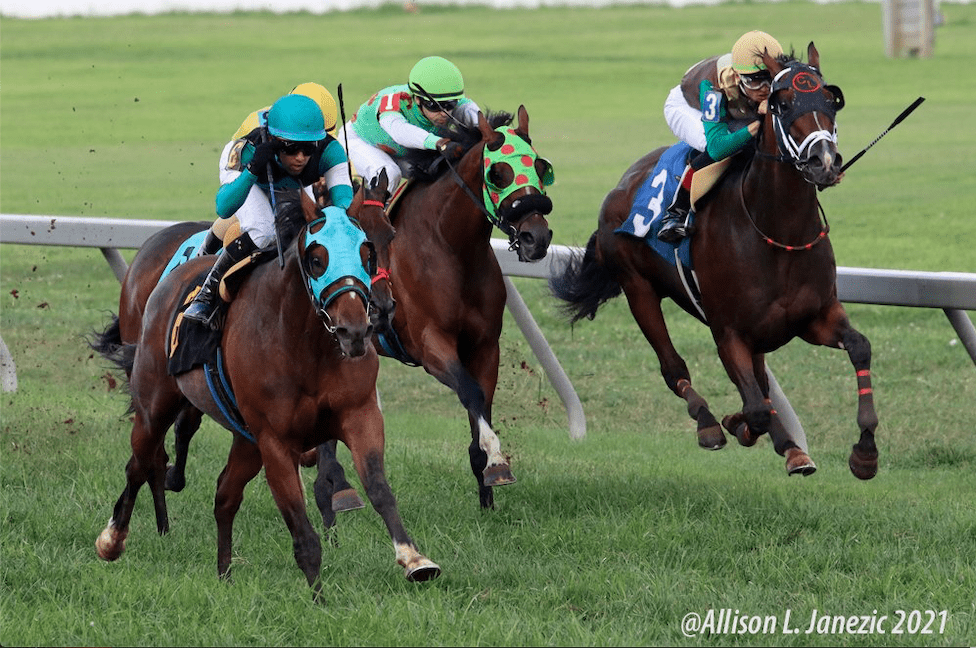
Somekindofmagician ridden by Angel Cruz breaks through the pack to win the Find by 1 ¾ lengths. (Allison Janezic)
Bell Gable Stable’s Somekindofmagician ran his win streak to three while earning the first career stakes win for himself and his owners with a last-to-first, 1 ¾-length victory in the $75,000 Find.
Rating well back of pacesetter Trifor Gold, who was in front through splits of 25.02 seconds, 50.72 and 1:15.40 before being reeled in by a group led by Nick Papagiorgio, Somekindofmagician trailed each of his six rivals midway around the turn. Jockey Angel Cruz moved the 7-year-old gelding off the fence approaching the stretch and set down for a stretch drive.
Nick Papagiorgio held on for second, a neck ahead of Alwaysmining, who rallied up the rail for third. Trifor Gold stayed up for fourth with 3-2 favorite Cannon’s Roar checking in fifth followed by Benny Havens and Closer Look. The winning time was 1:48.13 over a turf course rated yielding.
Somekindofmagician entered the Find off successive $20,000 optional claiming wins at Delaware Park July 21 and Aug. 7, the latter at 1 1/16 miles. They were his first wins since a similar spot last summer at Parx for previous trainer Jamie Ness; he joined trainer Gary Ness this spring.
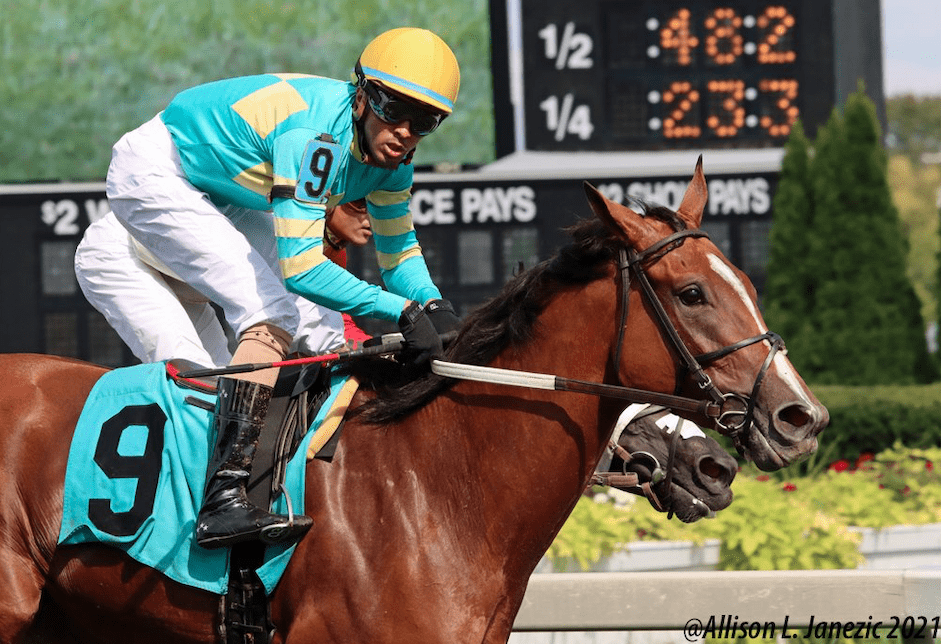
Kiss the Girl with Victor Carrasco up won the All Brandy. (Allison Janezic)
Three Diamonds Farm’s Kiss the Girl came with a steady drive down the center of the track to catch Awesome Jazz approaching the wire and edge clear to a neck length victory in the $75,000 All Brandy.
It was the second victory of the day for both jockey Victor Carrasco, who took Race 5 on Elusive Jester ($15.20), and trainer Mike Trombetta, winner of Saturday’s opener with Mosler’s Image ($18.60).
Already a stakes winner on the dirt, Kiss the Girl ($12.20) completed 1 1/16 miles in 1:48.53 over a yielding turf course. Awesome Jazz was a length ahead of 50-1 long shot Holly’s Lady in second, with another 1 ½ lengths back to Good Life Cider in fourth.
Kiss the Girl began her career with Hall of Fame trainer Steve Asmussen before Three Diamond’s Kirk Wycoff sent her to Trombetta last fall. She raced six times on the dirt, winning the March 13 Conniver at Laurel Park, but her last two races had come on the grass. She was fourth in the July 7 Peach Blossom at Delaware Park and second by 1 ¼ lengths in a one-mile optional claimer July 23 at Pimlico.
Kudos Maryland Jockey Club!
We applaud Maryland Jockey Club for presenting such a fine program on Maryland Pride Day and for giving the fans their Appreciation Day.
Due to the rebuilding of Laurel Park’s main track, Pimlico’s Preakness meet was extended from ending Monday, May 17 to ending Sunday, August 22, giving Pimlico its longest meet in decades—almost four full months. MJC presented two big stakes days and drew good-size crowds to those events and in general for their Friday-Saturday-Sunday schedule. We hope they see the results as positive and are encouraged to consider a longer meet for Pimlico in the future.
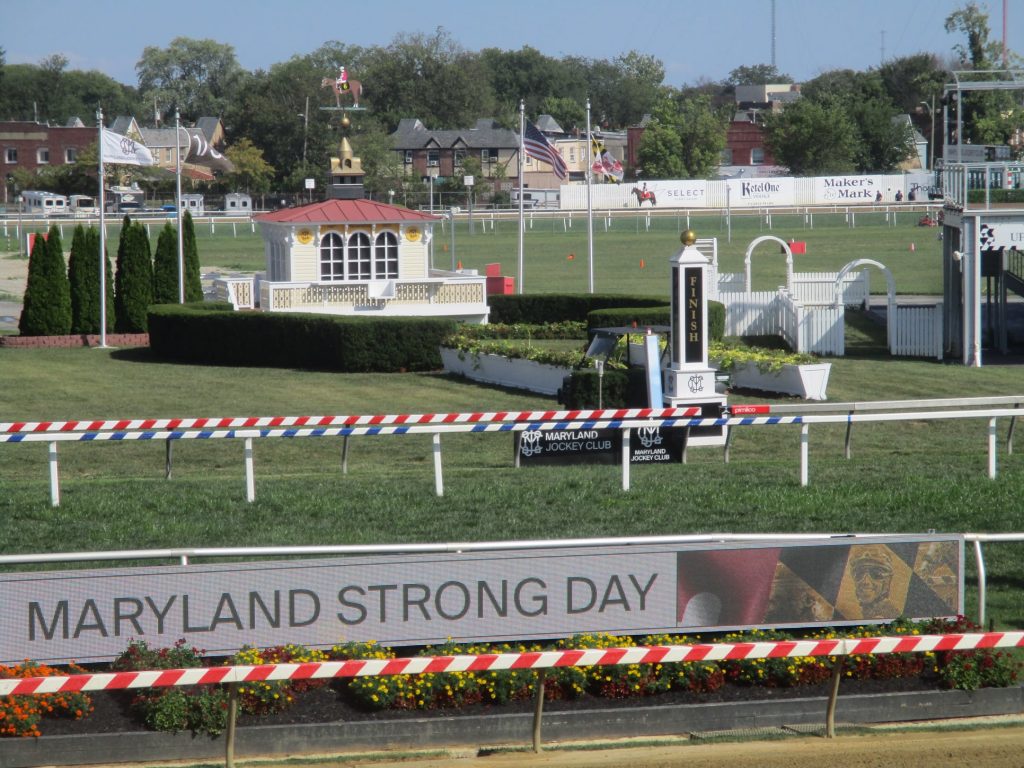
The iconic cupola in the Pimlico infield. (April Inloes Smith)
SIDE RAIL: The History of Pimlico’s Infield Cupola
Every year the Woodlawn Vase is resented to the Preakness victor on the infield cupola. Many fans believe this is the top of the original Old Members Clubhouse. Well, it’s not. Sadly, the original iconic 1870 structure burned to the ground in 1966 taking with it racing treasures and leaving only a scorched weathervane with the winning colors of Kauai King.
So, when did the other cupola appear? Searching through historical photos the first usage of the infield cupola as a presentation platform was 1962. Apparently, there was a special presenter who requested a “stage” so to speak. She was Academy-award winning Joan Crawford in full eyebrows and lipstick. Apparently, Ms. Crawford needed some positive press, and her agent thought the Preakness was a premier event to give his client. How’s that for Hollywood in Charm City!
Oh, and the winner of the 1962 Preakness was Greek Money. (See more about the 1962 Preakness at the end of the article)
And there you have it!
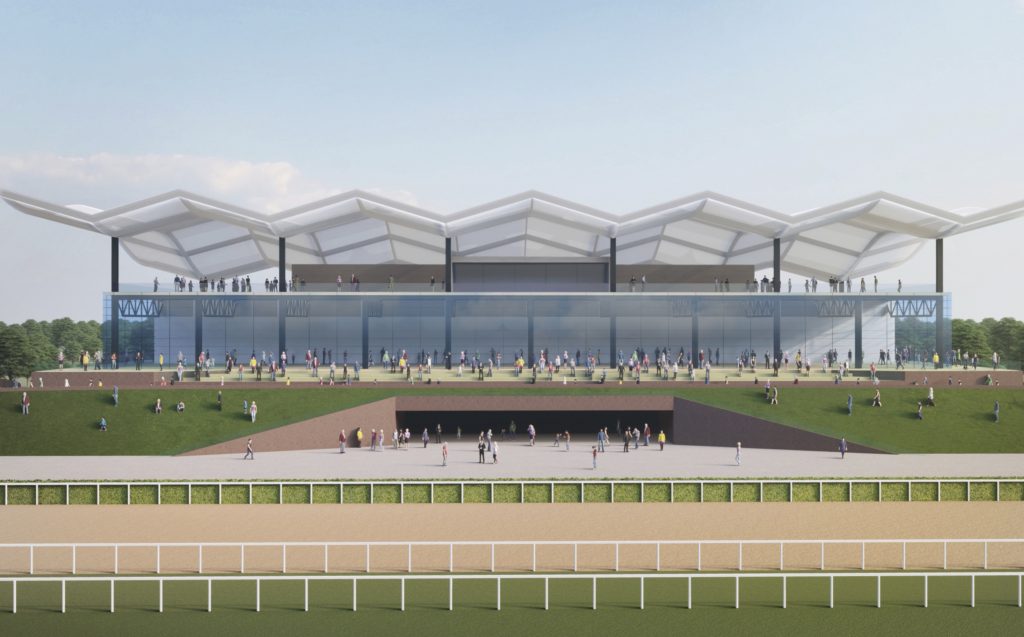
Elevation rendering of the new Pimlico clubhouse/civics center presented at the Fall 2019 meeting by Maryland Jockey Club.
Multi-purpose event center: This would be a linchpin of the new Pimlico. On race day, grandstands would be placed in the plaza in front of this structure, adjacent to the paddock. The building would house off-track betting. But it could also be the site for banquets, community meetings, youth and senior fitness classes, and other uses. Traditional grandstands and clubhouses can feel closed in. The idea here was to create a space that looks and feels accessible to the track and has many uses. “It is completely customizable,” said former Baltimore Development Corp. President William H. Cole IV, who represented the city in talks about the plan.
What is the future of Pimlico?
As far as we know, there are no set plans to go forward presently with the rebuilding of Historic Pimlico Race Course. The contract for design and engineering was awarded to internationally renowned Baltimore firm Ayers Saint Gross.
In a 2012 article by Cision PR News to celebrate ASG’s 100th Anniversary, it was noted:” Founded in 1912 as Sill, Buckler & Fenhagen, one of the firm’s first projects was a betting parlor at Pimlico Race Track.”
Recreating that betting parlor would be coming full circle. Comforting to know the rebuild is in the hands of a firm that understands and respects Baltimore history and tradition. We hope they honor that tradition.
The plans presented in the Fall of 2019 showcased a very cold and sterile new Pimlico facility. A simple glass building on a hill with a fluted roof. No permanent seating, no apron, no barns, no horses, no daily training. The track itself to be moved, rotated and shortened. It will be the only Triple Crown Race ever run on a 15/16th of a mile track.
It is rumored the old grandstand, closed in 2019, will be soon torn down.
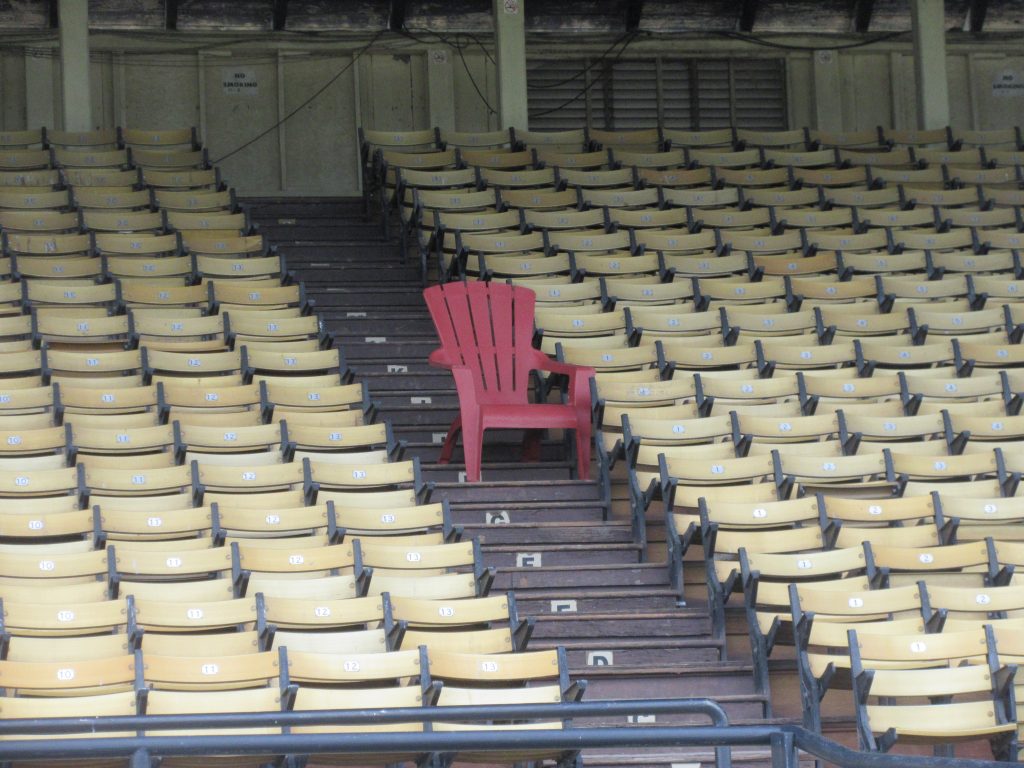
Seating at the old grandstand closed due to safety issues in April 2019. (April Inloes Smith)
Partially demolished to make room for the new big grandstand in 1954, the old grandstand was built in 1922 and stretched along the stretch to the finish line with a dogleg in the roofline. The roofline, itself, was lowered for the sightline except for the very end.
The 1922 grandstand replaced the 1894 version that replaced the original beautiful Victorian structure that burned down.
Will the Preakness stay at Pimlico?
Yes! Baltimore City Delegate Sandy Rosenberg (D-District 41) confirmed for us that the law had indeed changed. In fact, it has changed three times.
Let’s revisit the legislation and start with the law that made it illegal to move the Preakness out of Baltimore and away from Pimlico.
According to law and/or legend, it is a law in Maryland that the second jewel in the Triple Crown, the Preakness, can never be run at any other track than Pimlico Race Course in Baltimore, Maryland.
I could not find a copy of the original 1987 bill making it a law to prevent the Preakness from moving to any other track than Pimlico Race Course. There is no way to verify the exact language.
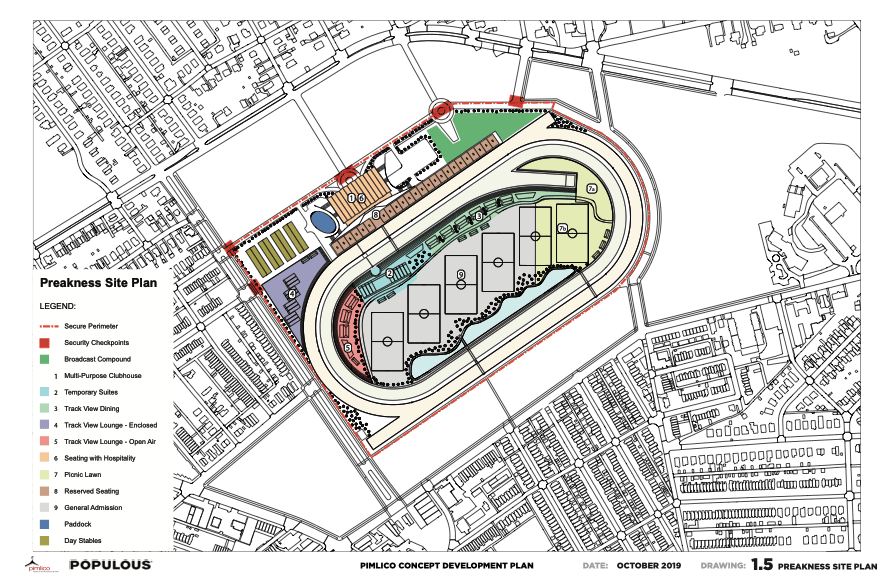
Site plan of Preakness overlay and layout by Polulus presented in fall 2019.
In a Baltimore Sun article from 2015 Pamela Woods discusses the original bill.
“Under a Maryland law passed in 1987, the Preakness can be moved to another track in the state “only as a result of a disaster or emergency.” That law, which is part of the state’s regulations on businesses, would need to be changed by the Maryland General Assembly to move the high-profile race, according to the state attorney general’s office and others.
The language was part of a bill that legalized — among other things — Sunday racing at Pimlico, where the Preakness recently held its 140th running.
During a hearing on the legislation at the time, a state senator asked one of the track’s then-owners whether he was OK with the provision preventing a transfer of the Preakness elsewhere in the state. The owner said it would be OK if the amendment allowed for an exception for an unforeseen event, such as a fire, according to Sandy Brantley, an assistant attorney general who advises state lawmakers.
Given the law, the path for moving the Preakness from Baltimore to Laurel Park would have to go through Annapolis, officials said.”
However, a subsequent piece of legislation I discovered had a phrase I had never noticed nor heard quoted before: “if Pimlico no longer exists.”
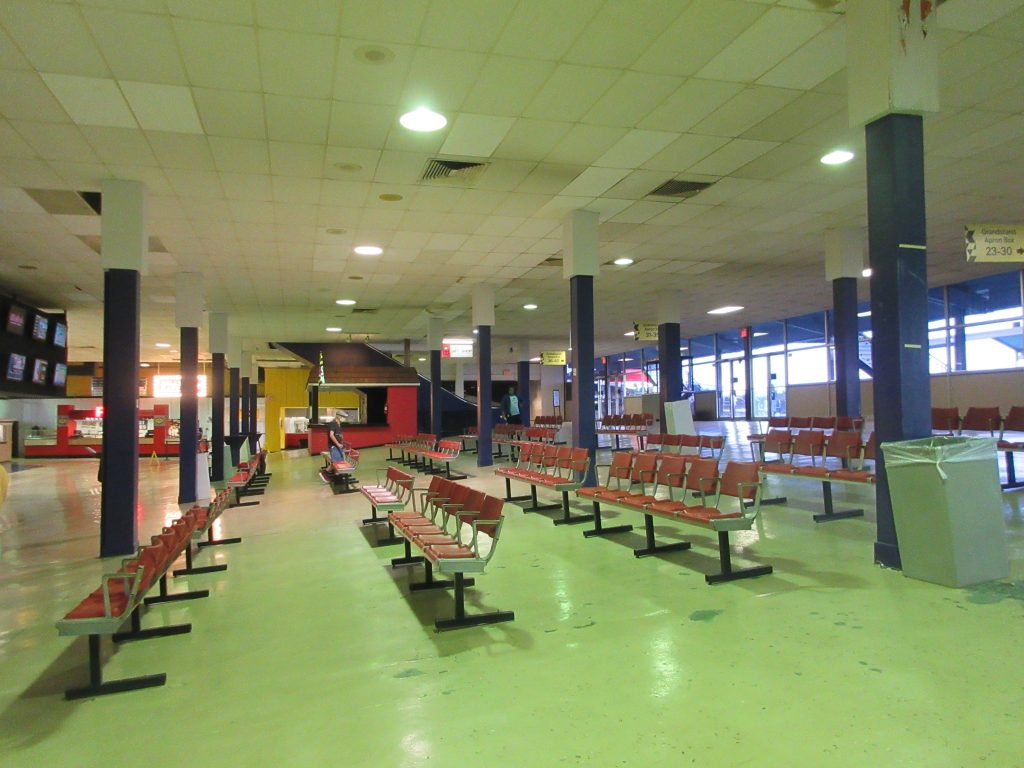
Pimlico’s grandstand interior has not been updated for several decades. (April Inloes Smith)
Let me put that into context.
Horse Racing – Distribution of Video Lottery Revenues
HB 1039 passed May 9, 2011
(b) (2) if the racing licensee holds the racing license for Pimlico Race Course, retain in the State of Maryland the name, common law and statutory copyrights, service marks, trademarks, trade names, and horse racing events that are associated with the Preakness Stakes and the Woodlawn Vase;
(3) if the racing licensee holds the racing license for the Pimlico Race Course, promote and conduct the Preakness Stakes each year at:
(i) the Pimlico Race Course; or
(ii) if the Pimlico Race Course no longer exists, the Preakness Stakes Race is prevented from being conducted at the Pimlico Race Course, or the State Racing Commission, under § 11–513 of the Business Regulation Article, deems an emergency exists, another track located in the State that is approved by the State Racing Commission;
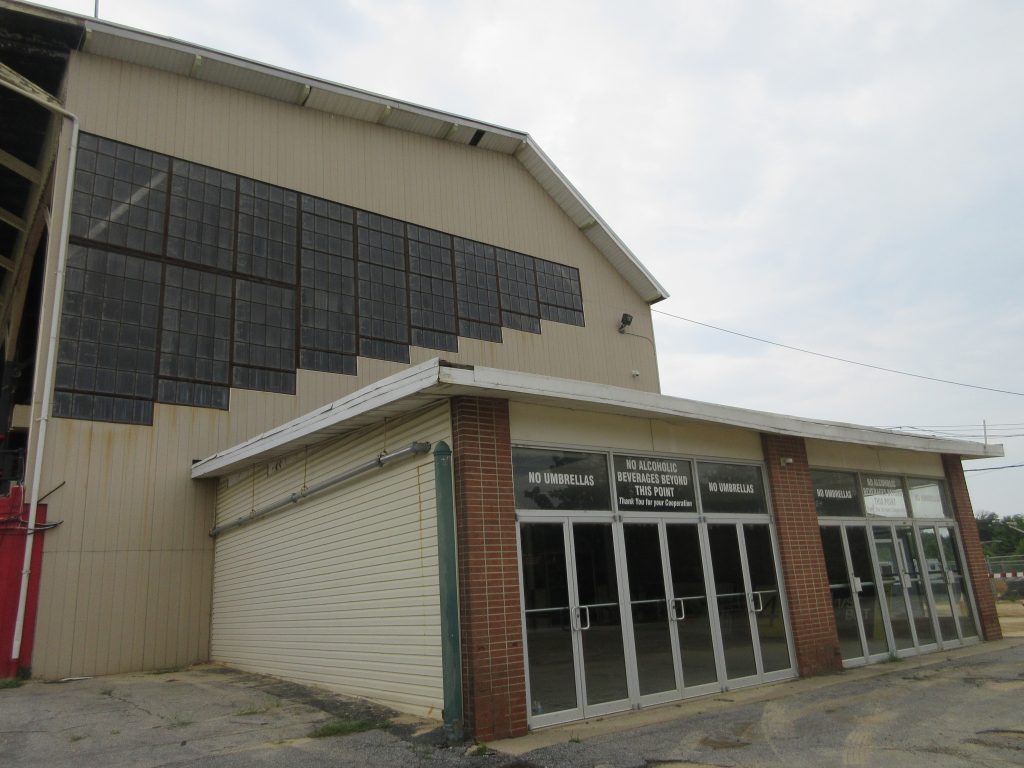
The entrance to Pimlico under the old grandstand. (April Inloes Smith)
A change in the language
The language “if Pimlico no longer exists” was stricken from SB987/HB1056. Therefore, when signed into law the Preakness, once again, cannot be moved from Pimlico.
This is still included in the law:
Section 11–520.
(a) The requirements of this section are established in recognition of the significance of the Preakness Stakes to the State.
(b) The Preakness Stakes may be transferred to another track in the State only as a result of a disaster or emergency.
(c) If the Preakness Stakes is transferred out of the State, the Commission may:
(1) revoke any racing days awarded to the Maryland Jockey Club of Baltimore City, Inc., or its successor; and
(2) award these racing days to another licensee, notwithstanding § 11–511(b) of this subtitle.
(d) (1) If the Preakness Stakes is offered for sale, the State has the option to buy the Preakness Stakes for the amount of any offer that the licensee wishes to accept.
(2) Within 30 days after receiving an offer that it wishes to accept, the licensee shall give the State notice of the offer.
(3) If the State wishes to exercise the option, it shall so notify the licensee within 60 days after it receives the notice.
The rest of the bill as it pertains to the details of the Pimlico rebuild is explained below.
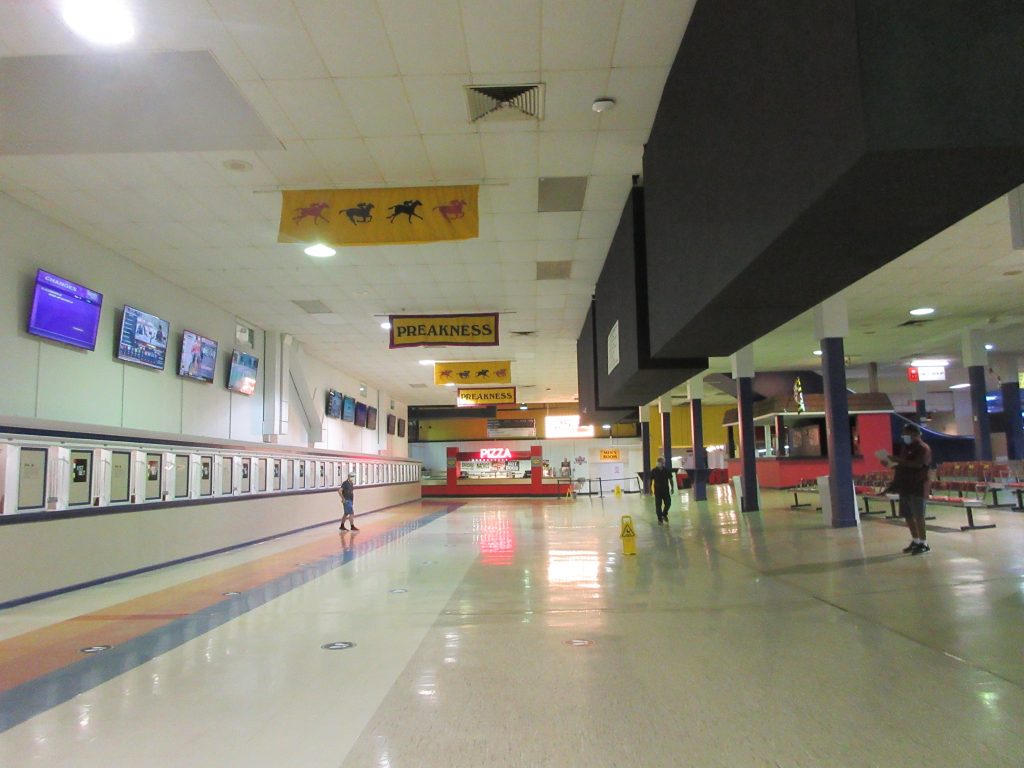
The betting windows in the Pimlico’s Grandstand. (April Inloes Smith)
The Racing and Community Development Act of 2020
A long-awaited bill to reinvigorate the Maryland horse racing industry became law without the Governor’s signature. Gov. Hogan chose to neither sign nor veto the bill allowing the legislation that was unanimously passed by the State Senate in March to become law on June 1, 2020.
Better known as “The Racing and Community Development Act of 2020” (SB987/HB1056) this legislation will fund the complete renovations of Pimlico Race Course in Baltimore, Maryland, and Laurel Park Racetrack in Anne Arundel County, Maryland.
In that bill, the language “if Pimlico no longer exists” was stricken from the law. Therefore, the Preakness will remain at Pimlico, or at least, some form of Pimlico.
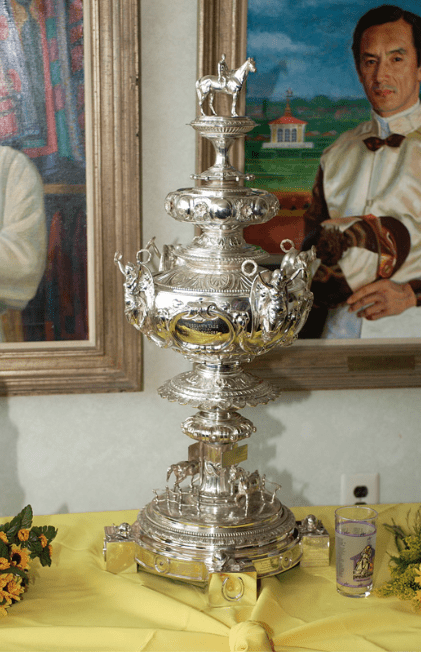
The irreplaceable, Woodlawn Vase valued at $4 million. (Craig L. Duncan, Public domain, via Wikimedia Commons)
The Deal for the “New Pimlico”
Under the agreement, TSG will retain ownership of The Preakness Stakes, the Woodlawn Vase and the Maryland Jockey Club. TSG would sign a 30-year lease deal to hold the Preakness at Pimlico, two months for set up and breakdown and pay $10 million a year for overlay for Preakness seating and accommodations such as temporary barns and hospitality.
The legislation requests $180 million for Pimlico, opened in 1870, and $155 million for Laurel Park, opened in 1911, to raise and rebuild both facilities from the ground up. Funding will be in the form of bonds sold through the Maryland Stadium Authority, monies from the Lottery and slots through the Racetrack Facility Renewal Account (RFRA). The bonds are required to be paid within 30 years.
All of Laurel’s 193 acres will be dedicated to development related to the track. There will be a modern, state-of-the-art grandstand built with all new barns and backstretch. In addition, there will be a new MARC train station built and bridges connecting the racetrack facility to the new TSG-owned Laurel Park Station multi-use development on the other side of the station.
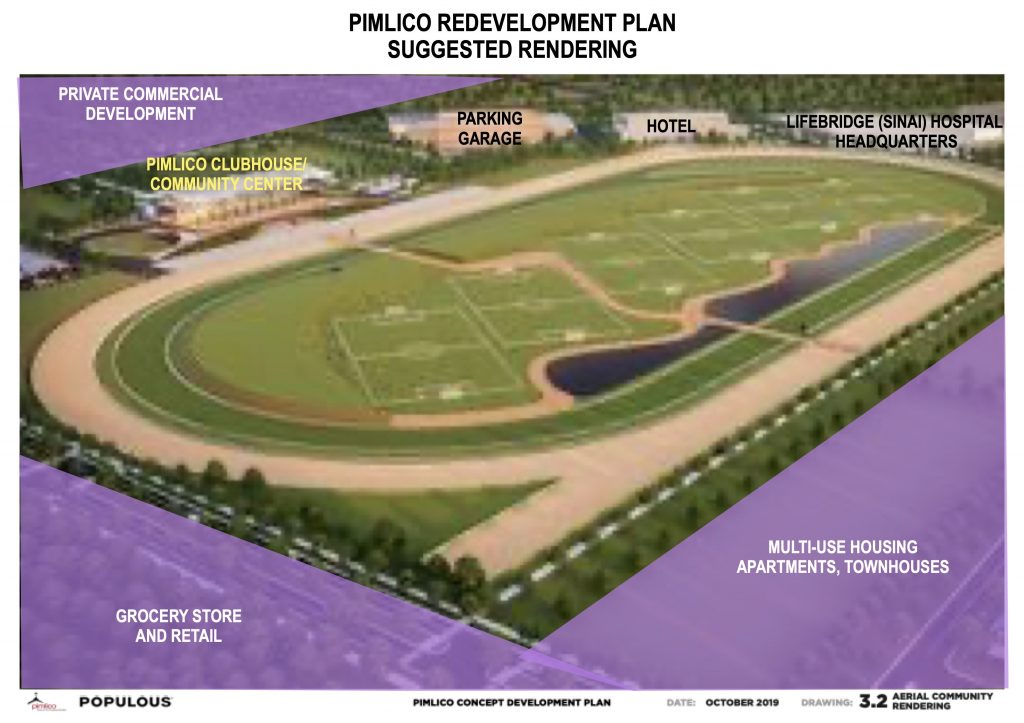
A concept rendering of Pimlico by Populus presented in fall 2019 showing the development zone.
Only half of Pimlico’s 110 acres will be related to the racing facility with the remaining surrounding acreage leased or sold for commercial development. Proposed are multi-use housing, a hotel and parking garage for use by Sinai Hospital and a grocery store. The current clubhouse built in 1960 and grandstand built in 1922, 1954 and 1959, will be replaced with a glass civic center/clubhouse. The racing oval will be rotated 30 degrees and shortened to 15/16th of a mile with two chutes. The infield will contain multiple athletic fields, a pond and footbridge.
The original 1870 Pimlico clubhouse, known as the Old Members Clubhouse, burned to the ground in June 1966 leaving behind only the weathervane, from 1909, that now resides in Pimlico’s museum. The only part original to Pimlico that still exists is the wrought iron gate that is located at the National Racing Museum and Hall of Fame in Saratoga, New York.
Bowie Training Facility, formerly Bowie Race Track which opened in 1914 with racing ending in 1983 and the training facility permanently closed in 2015, was to be transferred in ownership under the original language of the bill. Part of that facility’s land would be turned over to the Maryland-National Capital Park and Planning Commission for recreational activities, such as hiking and wildlife viewing, and to the city of Bowie and Bowie State University for activities such as baseball and football. However, subsequent amendments provided for the possibility that Bowie could reopen in a training center capacity.
The legislation is not limited to Pimlico, Laurel and Bowie. In fact, it is quite complicated. The legislation also calls for the creation of an Equine Health, Safety and Welfare Advisory Committee under the Maryland Racing Commission.
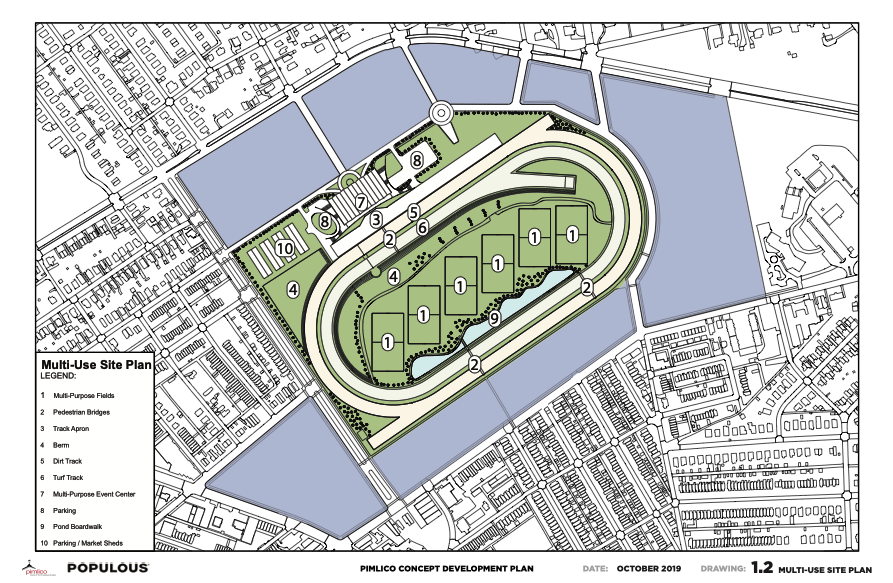
Pimlico multi-use development site plan by Populus presented in fall of 2019.
The Funding
TSG is seeking $389 million for rebuilding both facilities. The legislation would allow up to $375 million worth of bonds to be issued for the projects, though racing officials believe they may need to use only about $348 million in bonds.
The Maryland Stadium Authority would borrow money upfront to pay for most of the work, in the form of bonds that would be sold on the market. Those bonds would be paid back over 30 years using $17 million per year from the Maryland Lottery.
The lottery would be replenished from three sources:
– $5 million annually in money from slot money from the Purse Dedication Account (PDA) referred to as the “horsemen’s contribution.”
– $3.5 million annually in slots money that had been going to community aid in Baltimore.
– $8.5 million annually from the slots-funded Racetrack Facility Renewal Account (RFRA), money that had been set aside for facility capital improvements (due to sunset in 2035).
– The project also would use about $24 million that will be built up and sitting in the Racetrack Facility Renewal Account by March 2021 and $17 million in a one-time payout from the Maryland lottery.
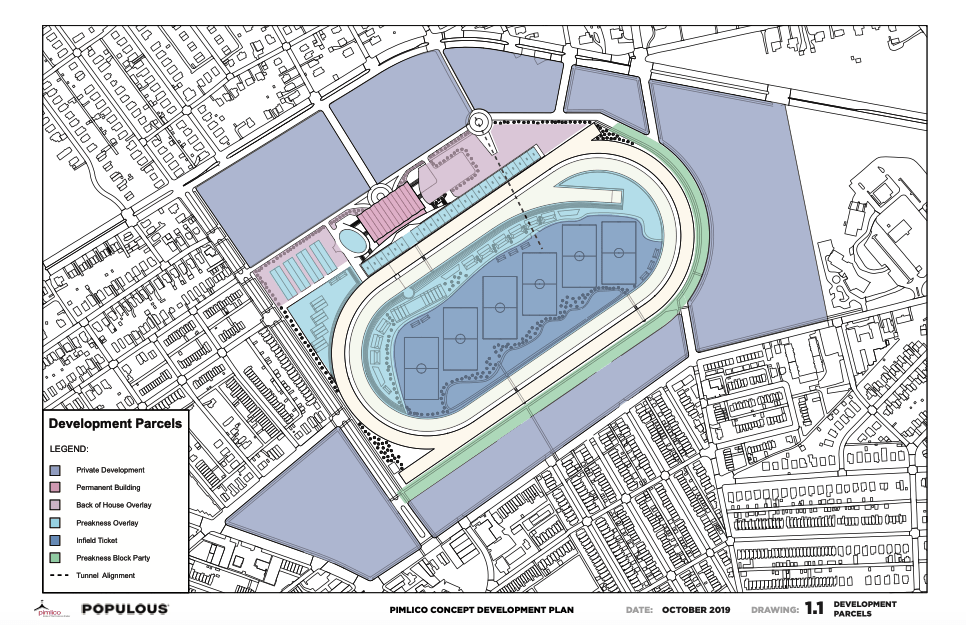
Site plan showing Pimlico development parcels.
Under Maryland law, the state’s horsemen receive subsidies from slots to supplement purses (PDA), while The Stronach Group receives grants from slots revenues to fund capital improvements (RFRA), if plans are submitted beforehand, all terms and deadlines are met, and those funds are matched by the company. The proposal would allow those subsidies to be used to underwrite the bonds, which would have a 30-year maturation. That would require a change in existing state law, which guarantees the slots subsidies through the end of 2035, covering less than half of the 30-year term of the proposed bond.
The plan also calls for a break on the sales tax for construction equipment and other materials that will be used in redeveloping of both facilities. Lawmakers have approved a similar sales tax exemption for other large projects in the state.
Laurel Park clubhouse concept rendering.
Laurel Park Goes First
For Laurel, The Stronach Group (TSG) would enter into a ground-lease arrangement with Anne Arundel County or a county-designated entity that would run for at least 30 years. The company would have the option of regaining full ownership of the property at the end of the lease.
Total Project Costs = $173,365,000:
+ Demolition, Infrastructure, Site Work = $47,917,000
+ Barns, Training, Backstretch = $57,270,000
+Clubhouse and Paddock = $68,178,000
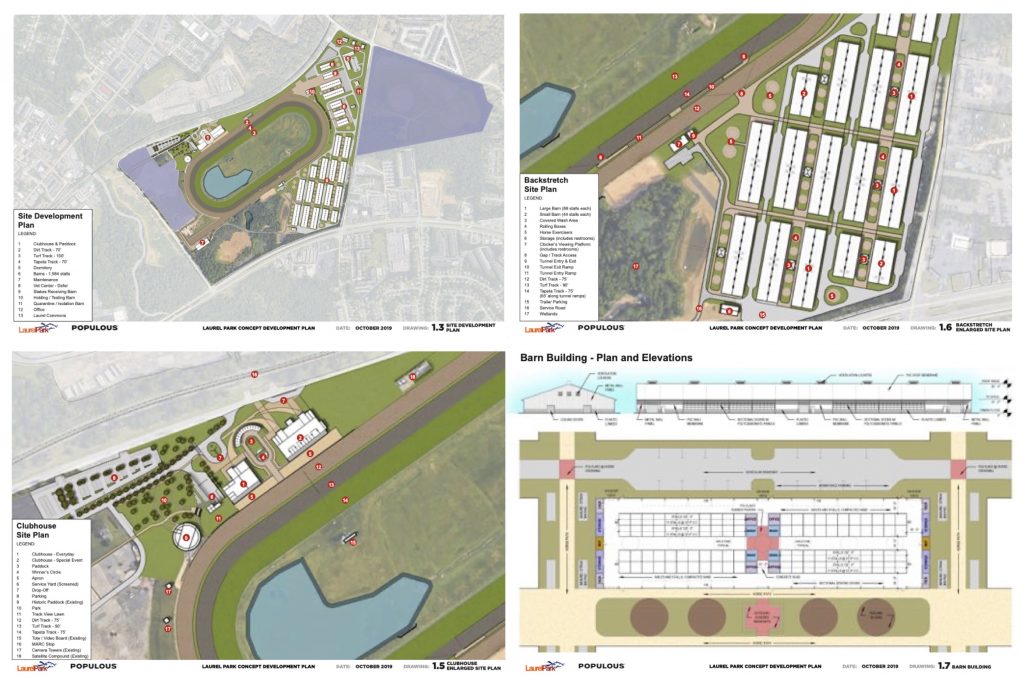
Laurel Park site plans and barn elevation.
Renovated first, Laurel would continue to be the focus of year-round racing in Maryland. Laurel will function as a supertrack and year-round training facility with a Tapeta track added between the turf and dirt tracks, a new modern clubhouse and all new barns and backstretch. The iconic Laurel paddock will be saved and repurposed. Click here to view the Laurel Concept Plans
Pimlico’s Turn and The Preakness Is Still Running
TSG would turn Pimlico over to Baltimore City or a city-approved entity such as the Maryland Stadium Authority.
Total Project Costs = $199,547,000:
+ Demolition, Infrastructure, Site Work = $101,302,000
+ Tracks, Infield, Community Spaces = $33,099,000
+ Multi-purpose Clubhouse and Events Center = $65,146,000
Then Pimlico gets a complete overhaul in 2023 and 2024 with the Preakness being held there during construction. Instead of a racing-focused facility, Pimlico would be renovated into a multiuse facility that would be used most of the year for youth sports, festivals and other events.
Pimlico’s expansive physical plant, including the clubhouse built in 1959 and backstretch, will be leveled replaced with a small glass multi-purpose clubhouse surrounded by commercial development on approximately 50% of the property. The racing oval dirt and turf tracks will be rotated and shortened to 15/16th of a mile with two chutes. The infield will be replaced with berms, a pond and footbridge and athletic fields.
The facility will cease to operate as a year-round training facility, will have no barns or dorm quarters on the backstretch. Ship in temporary stables and accommodations will be constructed for the Preakness meet.
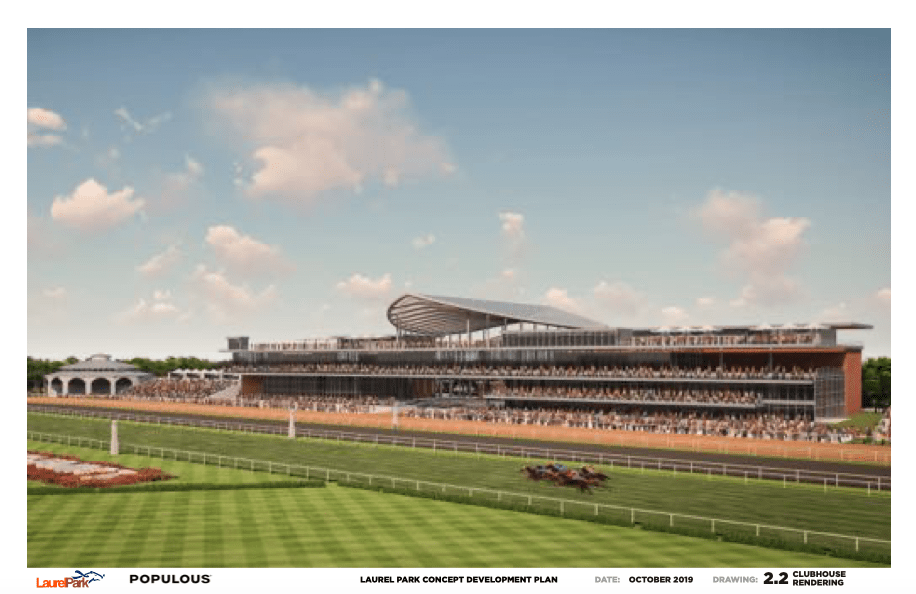
Rendering of Pimlico Race Course shown with fans and horses racing.
According to plans released in October 2019, the new clubhouse would not have fixed seating and would be a hospitality area for guests in reserve grandstand seats. For the Preakness capacity is estimated at 51,500 including various suite and reserved seating options trackside and turfside including accommodations for 8,000 in an infield picnic area, 12,000 reserved seats along the home stretch and 20,000 general admission tickets for access to the infield. Click here to view the Pimlico Concept Plans
Odds and Ends
The proposal would entail the creation of several new government agencies to manage the properties and construction. The Stronach Group, operating as the Maryland Jockey Club, would receive a license to operate racing at the two tracks contingent upon adhering to current state laws and regulations. MJC would be required to have at least 180 racing days each year, between Laurel and Pimlico.
1962 Preakness: The race where “All Heck Broke Loose”
Ms. Crawford presented the Woodlawn vase to the owner, trainer and jockey of Greek Money. The son of Greek Song out of Nimbus (GB) mare Lucy Lufton (GB) completed the 1-3/16th of a mile in 1:56.20 to defeat Ridan by a nose. Well, sort of.
The race was dubbed as the stretch duel in which “All Heck Broke Loose” and was captured by longtime Baltimore Sun photographer Joseph A. DiPaola, Jr., Panamanian rider, Manuel Ycaza up on Ridan attempted to interrupt the forward momentum of John Rotz aboard Greek Money. DiPaola, Jr., snapped the dramatic photo the very instant of the incident at a head on angle. Read more and see the photo in the New York Times in Leslie Knauf’s blog The Rail.
To see the photo of the trophy presentation and other iconic Preakness photos that span a century visit The Baltimore Sun Dark Room.
Jockey, John L. Rotz has won at least 70 of the most prominent graded stakes races in North America and many of them he won several times. These included: The Black Helen Hcp., Jim Dandy, Comely, Belmont Futurity, Hopeful, Laurel Futurity, National Stallion Stakes (filly division), Red Smith Hcp., Spinaway and the Withers—all in 1966!
Rotz was given the George Woolf Memorial Jockey Award in 1973 and was inducted into the National Racing Museum and Hall of Fame in 1983. His mounts include Gallant Bloom, Carry Back, Dr. Fager and In Reality.
John Rotz passed away July 12, 2021, at the age of 86.
Trainer Virgil “Buddy” W. Raines won the Arlington Classic with Greek Money’s sire, Greek Song, in 1950. Raines won two dozen important stakes between 1944, the Delaware Hcp., and 1991, the Maryland Million Classic and the Brooklyn Hcp.
Racing runs in the family as Buddy Raines was close with his two grandsons who became jockeys, John and Mike Luzzi, the latter also won the the Maryland Million Classic and the Brooklyn Hcp.
Raines was inducted into the Delaware Park Wall of Fame in 2008. He was nominated to the National Museum and Racing Hall of Fame in 2006. The “Virgil W. Raines Distinguished Achievement Award” is given by Monmouth Park annually. The award honors an owner or trainer who has shown a dedication to the sport of Thoroughbred racing through exemplary conduct demonstrating professionalism and integrity.
Raines died in Aiken, South Carolina in 2000 at the age of 89.
Owner Donald Peabody Ross (Renappi Corporation) co-founded Delaware Park and Brandywine Stable. In addition to Greek Money another of the stable’s top runners was the 1966 American Champion Older Dirt Female, Open Fire.
Ross was a steward of The Jockey Club, a president of the Thoroughbred Racing Association, and a founding member of the Board of Trustees of the National Museum of Racing and Hall of Fame.
Donald Ross died in 1973 at the age of 71.
1962 Preakness
Hi Ho Pimlico!
By Maribeth Kalinich, Editor, Past The Wire



